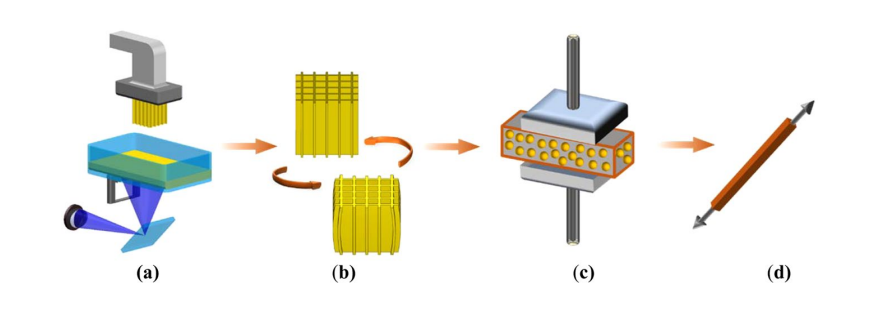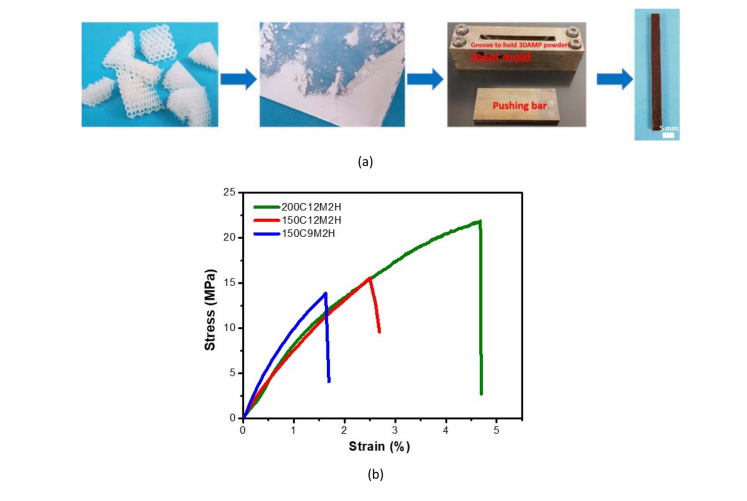Authors Ang Li, Adithya Challapalli, and Guoqiang Li explore a trend that continues to grow: 4D printing. Their findings are explained in the recently published “4D Printing of Recyclable Lightweight Architectures Using High Recovery Stress Shape Memory Polymer.” Here, the benefits of smart materials that can adapt to their environment are explored as the researchers consider challenges in 3D printing self-healing shape memory polymer (SMP) microlattices, and move forward to develop their own thermoset polymer offering the following features:
- High strength
- High recovery stress
- Perfect shape recovery
- Good recyclability
- 3D printability with DLP
The ability to create lightweight structures is one of the greatest benefits of 3D printing, but users are continually looking for better ways to have it all, including good mechanical properties. This is especially important in advanced engineering applications where capabilities such as the following are in demand:
- Shape memory
- Recovery stress
- Damage healing
- Recyclability

Schematic of recyclable and shape memory microlattices using 3D-RSMP. (a) 3D printing (direct light printing (DLP) of advanced multifunctional microlattice structures using the 3D-RSMP. (b) Compression programming of the printed microlattice to a temporary shape and recovery to the original shape. (c) Recycling of the ball milled multifunctional microlattices under high pressure and high temperature. (d) The remolded specimen for mechanical tests.
3D printed shape memory polymers tend to offer better potential, offering higher speed in production, less energy consumption to produce, and less post-processing. Shape memory effect is usually improved too, in what is ultimately the process of 4D printing, bringing forth ‘stimuli-responsive self-evolving features’ which offer better performance for load-bearing parts and structures. Before this study, however, the researchers found a resource for SMPs with high stress output lacking. Creating a higher-performance SMP meant turning to thermosets and either DLP or SLA methods.
The research team created a specialized 3D-RSMP resin for universal DLP 3D printing, offering mechanical properties they believe to be as good as some of the ‘best commercial DLP resins without multifunctionality,’ with higher shape memory and better self-healing qualities. 3D structures were designed in SolidWorks and then 3D printed on the Asiga Pico 2, with 3D-RSMP resin with 0.15mm layer thickness. Samples were also tested for recycling, crushed and broken, and then ground up via ball milling. Afterward, the researchers added the particles to a steel mold, with pressure applied at 200 °C or 150 °C for 2 hours.

Recycling of the crushed microlattices. (a) A recycling process is described: broken and failed shape memory microlattices were crushed into powders via ball milling; a steel mold was used for recycling milled powders of 3D printed microlattice structures under varying conditions. A mechanical test was performed on the remolded rectangular specimen made of the milled powders. (b) Typical tensile stress vs. strain curves of the remolded rectangular specimens obtained under varying conditions ((200C12M2H represents molding at 200 °C and under 12MPa pressure for 2h; 150C12M2H represents molding at 150 °C and under 12MPa pressure for 2h; and 150C9M2H represents molding at 150 °C and under 9MPa pressure for 2h) with a loading rate=0.5mm/min at room temperature.
The 3D-RSMP product appears so far to be the only SMP that can be both 3D printed and recycled—with recovery stress larger than 10MPa. In terms of application, the researchers also found their cubic microlattice to have the highest mechanical strength ‘with comparable or even higher specific compressive strength than metallic microlattices and ceramic microlattices without shape memory effect.’
“The results show that the cubic microlattice has mechanical strength comparable to or even greater than that of metallic microlattices, good SME, decent recovery stress, and recyclability, making it the first multifunctional lightweight architecture (MLA) for potential multifunctional lightweight load carrying structural applications,” concluded the researchers.
“Future work will be focusing on improving the recycling efficiency of the 3D-RSMP and the microlattice, and further optimizing the geometry through topological optimization or biomimicry in order to obtain microlattices with higher mechanical strength and shape memory effect for advanced structural and engineering applications.”

Mechanical properties of various microlattices upon compression. (a) Compressive strength vs. apparent density plots of various microlattices and foams. (b) Compressive modulus vs. apparent density plots of the three microlattices in this study.
While 3D printing is a source of fascination around the world, still, 4D printing takes fabrication to another magical level as researchers produce innovations like tunable metamaterials, multi-metals, and processes for other industrial applications.

Tree unit cell geometries have been drawn in Solidworks and then assembled to the corresponding microlattice structures. (Row 1: unit cells, from left to right: Octet unit cell (OCT UC); Kelvin unit cell (KVNUC); Cubic unit cell (CBC UC), Row 2: 3D printed microlattice structures, from left to right: Octet microlattice structure (OCT LTC), Kelvin microlattice structure (KVN LTC), and cubic microlattice structure (CBC LTC); Row 3: multi-length scale microlattices, from left to right: 1st order octet truss (1O OCT) and 2nd order octet truss (2O OCT)). (Te scale bar applies to all the five lattice structures).
Subscribe to Our Email Newsletter
Stay up-to-date on all the latest news from the 3D printing industry and receive information and offers from third party vendors.
Print Services
Upload your 3D Models and get them printed quickly and efficiently.
You May Also Like
Consolidation in AM: How 2025 Is Shaping the Industry’s New Normal
The first half of 2025 has been marked by a clear shift in the additive manufacturing (AM) industry. Companies are no longer just focused on developing new tech by themselves....
Etsy Design Rule Change Reduces Selection of 3D Printed Goods
Online marketplace Etsy has implemented a rule change requiring all 3D printed goods on the site to be original designs. The update to the site’s Creativity Standards states, ¨Items produced using...
U.S. Congress Calls Out 3D Printing in Proposal for Commercial Reserve Manufacturing Network
Last week, the U.S. House of Representatives’ Appropriations Committee moved the FY 2026 defense bill forward to the House floor. Included in the legislation is a $131 million proposal for...
Transforming From Tourist to Native: Duro CEO Michael Corr Explains Why the Company Rebuilt its PLM Software on AI
In these early innings of the AI boom, many market analysts have expressed concern that AI spend has gotten too far ahead of the technology’s proven ability to deliver significant...
































